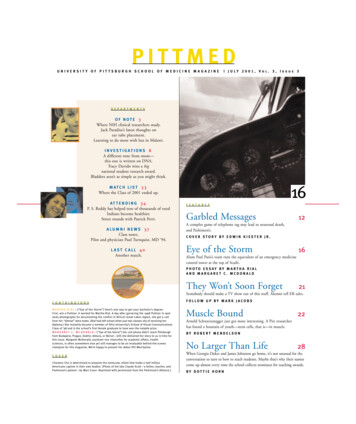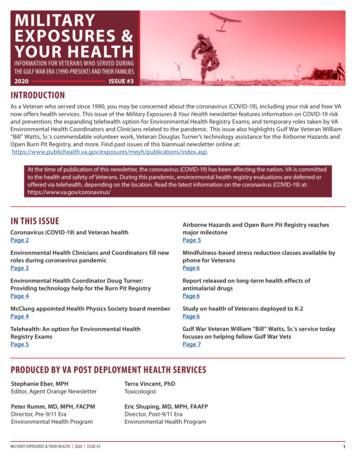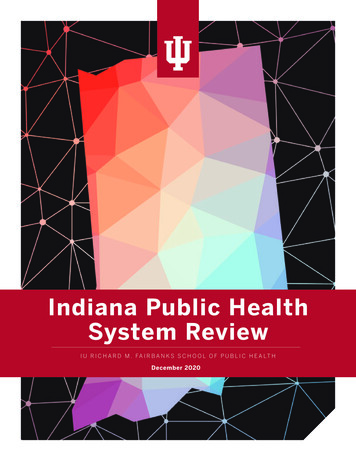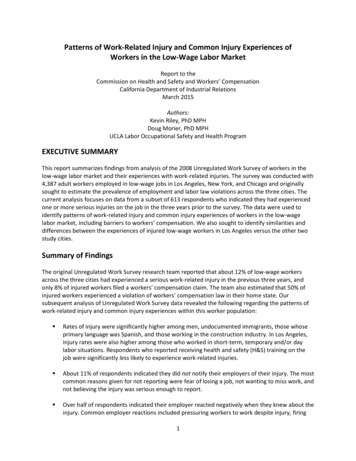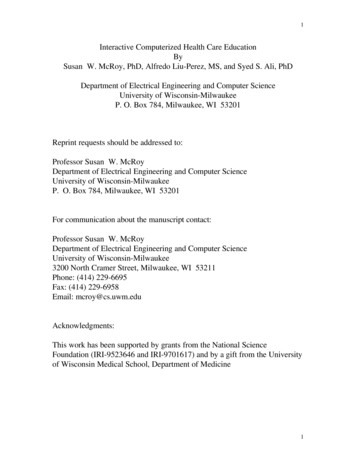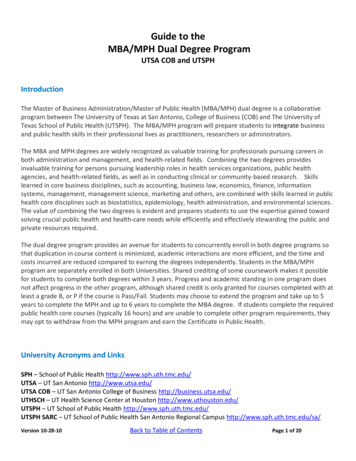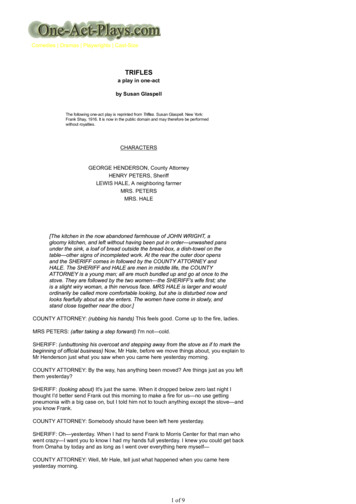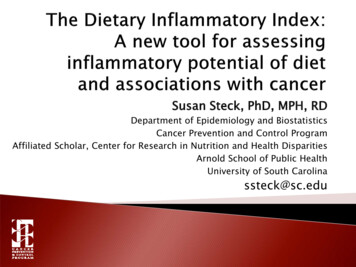
Transcription
Susan Steck, PhD, MPH, RDDepartment of Epidemiology and BiostatisticsCancer Prevention and Control ProgramAffiliated Scholar, Center for Research in Nutrition and Health DisparitiesArnold School of Public HealthUniversity of South Carolinassteck@sc.edu
No competing interestsResearch Support National Institutes of Health: F31 National Research Service Predoctoral Award to Dr. FredTabung Established Investigator Award in Cancer Prevention andControl from NCI (K05CA136975) to Dr. James Hebert Prevent Cancer Foundation – Living in Pink Grant American Institute for Cancer Research (beginning January 2015)CANCER PREVENTION& CONTROL PROGRAM
CANCER PREVENTION& CONTROL PROGRAM
Anti-inflammatory: Phytochemicals and micronutrients found invegetables and fruit Fiber/Whole grains Certain spices and seasonings Pro-inflammatory: Saturated fatty acids Trans fatty acids Cholesterol Adherence to healthy diet patterns, such asMediterranean diet, reduces concentrations ofinflammatory biomarkers.CANCER PREVENTION& CONTROL PROGRAM
Inflammatory response is necessaryfor normal immune response.NSAIDs reduce risk of some cancers,but with adverse side effects.Dietary modification is likely to besafer, perhaps more beneficial thanNSAIDs use.Diet as a whole is likely to be moreimportant than single constituents.CANCER PREVENTION& CONTROL PROGRAM
Be able to classify an individual’s diet rangingfrom the extremes of pro- to anti-inflammatoryand to adapt to diverse populationsProvide individuals with a tool to modify theinflammatory potential of their diet andresearchers with a global measure of thisinflammatory potential of the dietCANCER PREVENTION& CONTROL PROGRAM
1) 1943 articles on 45 foodparameters identified and scored2) Weight articles by study designand calculate pro- and antiinflammation fractions3) Adjust scores if totalweighted articles is 2364) Inflammatory effect scorecalculated from 2) and 3)5) -World composite database for 45 foodparameters based on data from 11 countries-Calculate world mean and standard deviationfor each of the 45 food parameters.Dietary intake madeavailable to the scoringalgorithm6) Based on available dietary intake datacalculate z-scores and centered percentiles foreach of the food parameters for eachindividual in the study, based on the worldaverage and standard deviation.7) Multiply centered percentile by the inflammatory effect score toobtain “component-specific DII score.”8) Sum all of the “component specific DII scores” to create the“overall DII score” for an individual.CANCER PREVENTION& CONTROL. PROGRAMShivappa et al, 2014, PHN
Due to the large number of articles oninflammation, the search was limited to six wellknown inflammatory markers:IL-1β, IL-4, IL-6, IL-10, TNF-α, CRPA total of 45 food parameters were included in the searchVariations in the names of food parameters were used to ensurefull representationEach food parameter was individually combined with the list ofinflammatory termsA total of 1943 articles published through 2010 qualified andwere indexed and scoredCANCER PREVENTION& CONTROL PROGRAM
Scoring StrategyOne of three possible values was assigned based on theeffect of the particular food parameter on eachinflammatory biomarker: 1 if pro-inflammatory0 if produced no change in inflammatory biomarker-1 if anti-inflammatoryCANCER PREVENTION& CONTROL PROGRAM
Type of StudyHumanStudy DesignValueExperimental10Prospective ntal5Cell CultureExperimental3CANCER PREVENTION& CONTROL PROGRAM
Using these weighted values, a score for each foodparameter was calculated using the followingsteps: Step 1: Divide the weighted pro- and anti-inflammatoryarticles by total weighted number of articles. Step 2: Subtract the anti-inflammatory fraction fromthe pro-inflammatory fraction.CANCER PREVENTION& CONTROL PROGRAM
Example for Saturated Fat9205 0.04497205 0.473CANCER PREVENTION& CONTROL PROGRAMShivappa et al, 2014 PHN
Weighting by the Size of the Literature Base The median weighted number of articles forthe 45 food parameters was 236To adjust for some food parameters having aless robust pool of literature, foodparameters with a weighted number ofarticles less than 236 were adjusted asfollows:1) Number of weighted articles was divided by 2362) The fraction was then multiplied by the score forthat food parameter, which resulted in the newadjusted score for each food parameterCANCER PREVENTION& CONTROL PROGRAM
Example for Saturated Fat9205 0.04497205 0.4730.429 * 205/236 0.373 (new adjusted score)CANCER PREVENTION& CONTROL PROGRAMShivappa et al, 2014 PHN
CANCER PREVENTION& CONTROL PROGRAMShivappa et al, 2014, PHN
1) 1943 articles on 45 foodparameters identified and scored2) Weight articles by study designand calculate pro- and antiinflammation fractions3) Adjust scores if totalweighted articles is 2364) Inflammatory effect scorecalculated from 2) and 3)5) -World composite database for 45 foodparameters based on data from 11 countries-Calculate world mean and standard deviationfor each of the 45 food parameters.Dietary intake madeavailable to the scoringalgorithm6) Based on available dietary intake datacalculate z-scores and centered percentiles foreach of the food parameters for eachindividual in the study, based on the worldaverage and standard deviation.7) Multiply centered percentile by the inflammatory effect score toobtain “component-specific DII score.”8) Sum all of the “component specific DII scores” to create the“overall DII score” for an individual.CANCER PREVENTION& CONTROL. PROGRAMShivappa et al, 2014, PHN
More negative scores represent antiinflammatory diet whereas more positivescores represent pro-inflammatory dietApproximate range is -10 to 10CANCER PREVENTION& CONTROL PROGRAM
Seasonal Variation in Blood Cholesterol Study (SEASONS) (n 500) DII calculated from 24 hour recalls and structured 7 day food records Third tertile of DII compared to first tertile associated with 47% to 61%increased odds of having elevated CRP ( 3mg/L)Women’s Health Initiative (WHI) ancillary study (n 2600): DII calculated from baseline FFQ More pro-inflammatory diet associated with higher: IL-6 (p 0.0001) hs-CRP [OR for elevated CRP 1.34 (1.01, 1.78) for Q5 vs Q1] TNFalpha R2 (p 0.002) Overall inflammatory biomarker score derived from a combination ofthe three biomarkers (p 0.0001)CANCER PREVENTION& CONTROL PROGRAM
Secondary data analyses of prospective cohort studies Iowa Women’s Health Study (colorectal cancer) Women’s Health Initiative (colorectal and breast cancers) NIH-AARP (colorectal cancers)DII calculated from baseline FFQsMultiple covariate-adjusted Cox proportional hazards regressionmodels used to calculate hazard ratios (HR) and 95%CIsCANCER PREVENTION& CONTROL PROGRAM
1.8Hazard ratio1.61.41.2Colorectal cancer10.80.6Q1Q2Q3Q4Q5DII QuintileCANCER PREVENTION& CONTROL PROGRAMShivappa et al. 2014 CEBP
1.8Hazard ratio1.61.4Colorectal cancer1.2Colon cancer10.80.6Q1Q2Q3Q4Q5DII QuintileCANCER PREVENTION& CONTROL PROGRAMShivappa et al. 2014 CEBP
1.8Hazard ratio1.61.4Colorectal cancer1.2Colon cancerRectal cancer10.80.6Q1Q2Q3Q4Q5DII QuintileCANCER PREVENTION& CONTROL PROGRAMShivappa et al. 2014 CEBP
1.8Hazard ratio1.6Colorectal cancer1.41.2Colon cancer1Proximal coloncancer0.80.6Q1Q2Q3Q4Q5DII QuintileCANCER PREVENTION& CONTROL PROGRAMTabung et al. under review
1.8Hazard ratio1.61.4Males1.2Females10.80.6Q1Q2Q3Q4DII QuartileCANCER PREVENTION& CONTROL PROGRAMWirth et al. under review
Breast cancer cases,n 5841Breast cancerHR (95%CI)aHER2 cases,n 662HER2 cancerHR (95%CI)aBreast cancer mortality,n 406Breast cancer mortalityHR (95%CI) bCANCER PREVENTION& CONTROL PROGRAMT1 (-7.055, 2.366)(healthiest)T2 (-2.366, 0.468)T3 (0.468, 5.789)(least healthy)2155191217741.00 (ref)0.95 (0.89, 1.01)0.99 (0.92, 1.06)2152222251.00 (ref)1.12 (0.92, 1.35)1.29 (1.05, 1.59)1171361531.00 (ref)1.06 (0.81, 1.37)1.30 (0.99, 1.71)Ptrend0.890.010.04aadjusted for age, race/ethnicity, body mass index, physical activity, education, smoking status, mammographywithin 2 years of baseline, age at menarche, number of live births, oophorectomy status, hormone therapy use,NSAID use, dietary modification trial arm, hormone therapy trial arm, calcium and vitamin D trial arm, and totalenergy intake; badjusted for age, race/ethnicity, body mass index, physical activity, education, smoking status,mammography within 2 years of baseline, hormone therapy use, NSAID use, dietary modification trial arm,hormone therapy trial arm, calcium and vitamin D trial arm, total energy intake, estrogen receptor status,progesterone receptor status, stage and time since diagnosisTabung et al. in preparation
Diet assessment at onlyone time point (baseline) FFQ measurement error Generalizability Potential residual orunmeasured confoundingMean DII by Shift Work inNHANES 2005-20101.51.00.50.0Day Shift Night Shift RotatingShiftWirth et al. 2014 JOEMCANCER PREVENTION& CONTROL PROGRAM
More pro-inflammatory DII scores were associated positivelywith inflammatory biomarkers.More pro-inflammatory DII scores were associated withincreased risk of colorectal cancer among postmenopausalwomen in the IWHS and WHI. Increased risk for men observed in the NIH-AARP though noassociation for women in NIH-AARP The DII was not associated with invasive breast cancer risk Suggestion of increased risk for HER2 cancers and for breastcancer mortalityCANCER PREVENTION& CONTROL PROGRAM
Examining DII using post-diagnosis dietary data inrelation to cancer survival.The DII can be applied in studies utilizing 24 hourrecall, food record or FFQ dietary assessment data.An “app” is under development to assist clinicians inscreening patients, and to help consumers movetoward a more anti-inflammatory diet.CANCER PREVENTION& CONTROL PROGRAM
James Hebert, Director,Cancer Prevention andControl Program,Distinguished ProfessorEPID, USCTom Hurley,Statistician,CPCP, USCFred Tabung, Postdoctoral FellowHarvard School of Public HealthAngela Liese,Professor,EPID, USCJudith Ockene,ProfessorYunsheng Ma,Assoc. ProfessorUMass Medical SchoolCANCER PREVENTION& CONTROL PROGRAMJiajia Zhang,Assoc. Professor,BIOS, USCMike Wirth,Res. Asst.Professor.CPCP, USCNitin Shivappa,PostdoctoralFellow,CPCP, USC
Ilir AgalliuCindy BlairBette CaanRowan T. ChlebowskiJo L. FreudenheimMelanie HingleGloria HoLifang HouDavid JacobsLi JiaoKaren K. JohnsonDorothy S. LaneLisa W. MartinAmy E. MillenYasmin Mossavar-RahmaniHannah L. ParkAnna PrizmentLihong QiMilagros C. RosalJames M. ShikanyLinda SnetselaarFrances A. TylavskyMara Z. VitolinsJean Wactawski-WendeCANCER PREVENTION& CONTROL PROGRAMAlbert Einstein College of MedicineUniversity of MinnesotaKaiser Permanente Division of ResearchUCLA School of MedicineSUNY Dept. of Social and Preventive MedicineUniv. Ariz. Dept. of Nutritional SciencesAlbert Einstein College of MedicineNorthwestern Univ. Feinberg School of MedicineUniversity of MinnesotaBaylor College of MedicineUniv. of Tennessee Health Science CenterStony Brook Univ. School of MedicineGWU School of Medicine and Health SciencesSUNY Dept. of Preventive MedicineAlbert Einstein College of MedicineUC Irvine Dept. of EpidemiologyUniversity of MinnesotaUC Davis School of MedicineUMass Medical SchoolUAB School of MedicineThe University of IowaUniv. of Tennessee Health Science CenterWake Forest School of MedicineSUNY Dept. of Social and Preventive Medicine
CANCER PREVENTION& CONTROL PROGRAMShivappa et al, 2014, PHN
CANCER PREVENTION& CONTROL PROGRAMShivappa et al, 2014, PHN
Anti-inflammatory: Phytochemicals and micronutrients found in vegetables and fruit Fiber/Whole grains Certain spices and seasonings Pro-inflammatory: Saturated fatty acids Trans fatty acids Cholesterol Adherence to healthy diet patterns, such as Mediterranean diet


